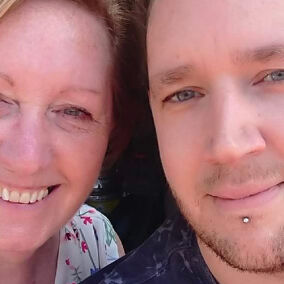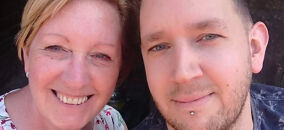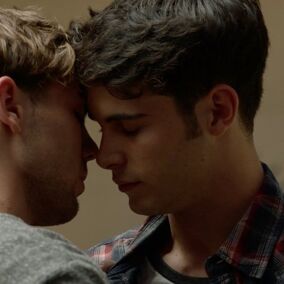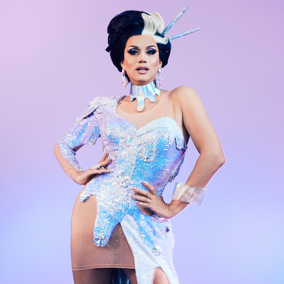
James Falciano is a champion of their queer community, something that is reflected in their art, activism, and everyday life.
So it’s no surprise that James, like thousands of others, has turned to OraQuick’s in-home HIV test as a key part of their sexual health toolkit.
It’s the simplest way to get accurate, fast results without waiting in line at the clinic or doctor’s office – if you can even get one these days. In as little as 20 minutes, in the privacy of your own home, you obtain your results, along with access to 24/7 support.
It’s the way to take control of your own sexual health and to own your own sex life.
How about we take this to the next level?
Our newsletter is like a refreshing cocktail (or mocktail) of LGBTQ+ entertainment and pop culture, served up with a side of eye-candy.
James and two other fabulous queer artists, Preston Nelson and Kitsch Harris, are partnering with OraQuick to encourage HIV self-testing.
Here are samples of their art to explore along with conversations about their work.
James Falciano
Hey James, this is not the first time you have partnered with OraQuick, right?
I’ve partnered with OraQuick a few times now, the first being last year for World AIDS day, as well as a recent Instagram-driven campaign to focus on the benefits of self-testing. As a professional queer artist, I always aim to celebrate and uplift my community through my artwork. Sometimes it’s through individual portraits, other times it’s highlighting important issues we face collectively. I feel strongly about combating the lingering stigmas around HIV and getting tested. It’s a wonderful thing that such a product now exists to minimize so much of the stress and anxiety about HIV status.
How would you describe your style of art?

Until recently everything I did was hand-drawn, but within the past few months I have switched over to drawing digitally on an iPad, which I’m loving. In terms of aesthetics, I’m partial to bold, vibrant color and lots of intricate detail. When it comes to meaning, I try to pour a lot of myself into the work. There is a lot of love that goes into what I create. I want to celebrate the queer community, to portray each subject in a radiant, celebratory light.
What is inspiring you now?
I’m always working on a bunch of projects simultaneously. Currently in the mix are portraits of specific individuals I’ve wanted to celebrate, a drawing with a more poignant theme to tie into National Coming Out Day, and some spooky inspired work just for fun with the Halloween season. For inspiration, the community of fellow queer artists I follow on Instagram is always a source of creative energy for me. There is so much talent out there, seeing the exciting work others make always inspires me to try new things out with my own work.
What’s the connection between your art and your HIV advocacy?
I wish to combat stigmas surrounding HIV and sexual health by sparking a positive dialogue.
What do you want others to take away from this unique advertising campaign?
I hope they feel empowered to have conversations with friends and partners about these issues. And to realize how lucky we are to have so much information at our fingertips now about HIV and sexual health, as well as options like OraQuick to make testing a much more seamless process.
Why do you think HIV self-testing is good for you and your community?
In-home testing is an amazing breakthrough. We have all been fearful to get tested at one time or another, not just because of what the result may be but because of the whole process of going to clinics. Medical environments can always be a little stressful and intimidating. The fact that there is an option to test in the privacy of one’s home alleviates fear.
Kitsch Harris

Hey Kitsch, what would you say gives your art meaning?
My art is hopeful. It’s always trying to look forward to a world or a future that’s within our grasp. I always create with the mindset that any character, setting, or circumstance is innately queer. For me, creating something that is countercultural is inspiring. I’m always trying to give the LGBTQ community, who aren’t always positively represented in mainstream media, a place to find art that speaks to us.
What is inspiring you now?
Self-Quarantining in NYC has been such a productive time for me. I’ve been really considering how to share my art with more people, and what avenue I can take over next. My biggest source of inspiration is watching tons of cartoons and YouTube Artists. It’s inspired me to launch a channel for people wanting to know my process, and hopefully share that same inspiration in their own art.
What’s the connection between your art and HIV advocacy?

My art is always a political statement. It’s giving a voice to the voiceless in a bright and inviting way. I hope my art always sheds some light on marginalized communities, even if it’s the tiniest seed of representation. After losing so many in the AIDS crisis, HIV advocacy is embedded in our community, and it’s not going anywhere. We as humans feel and remember the shared trauma of losing so many lives. It’s hard to explain, but there’s such a hole in my heart when thinking of all the culture, art, and lives that were lost in this period. I hope in some tiny way my art has the luxury of being a tribute to all the LGBTQ people that came before me. My art will always have themes of hope, acceptance, and love. These themes were not guaranteed to the generations before us, and they are so crucial to promoting safe spaces to talk about sexuality and HIV.
What do you want viewers to take away from this unique advertising campaign?
My main hope is that people see themselves in a fantastical way that maybe they’ve never seen themselves. We all want to charter new courses, and live in space – even have robots wait on us. We as queer people are allowed to dream and literally reach for the stars. That’s what this world doesn’t tell us. Getting tested is as easy as this daydream right? You can do it with no effort in the safety of your home, thanks to OraQuick. How amazing is that? This campaign is one of the few that gives the LGBTQ community a chance to be represented and provided information about a product that actually improves our quality of life.
Why do you think that quick HIV testing is good for your community?
For me personally, needles and doctors are scary. I grew up in a small town in Louisiana. Couple that with most Southerner’s stigma around being queer (and, especially, getting tested), a lot of people embedded this idea in my mind that if you don’t get tested, you don’t have HIV. It’s such a bad mindset that contributes to being uninformed and potentially spreading HIV.
The idea of being tested in the privacy of our own home has given so many people relief. I’m hoping to promote the idea that HIV testing is safe, easy, and something that we should be doing frequently. In the world we’re striving for, testing becomes so commonplace that we don’t even give it a second thought. It just becomes a normal part of everyone’s routine.
Preston Nelson

Hey Preston, describe your style of art.
My style of art is very gay. It has meaning because I’m gay and it’s gay and I make it for gay people. Okay, but on a more serious note, I’d describe my art as autobiographical. It’s sort of like keeping a journal for me. While I was joking about my art simply being gay, it’s also a bit true. I think it’s important to share honest queer stories. LGBTQ narratives are tragically underrepresented in almost every form of media. If a young queer person sees my art and makes a connection, then that’s all the meaning I need.
What are you working on right now?
It’s a piece about consent within the queer community. I think it’s a really important topic that gets misconstrued much too frequently. I’m also working on a series of comics about growing up queer and Korean-American. There are so many nuances to be found within identity. I’m currently inspired by the sense of community in New York City. I’m also constantly inspired by my friends and family finding the strength to make monumental changes in their own lives and the lives of others.
What’s the connection between your art and your HIV advocacy?

A lot of queer people are expected to learn about sexual health on their own. Growing up, everything that I learned was from a cisgender heterosexual perspective. The heterosexual perspective hasn’t exactly been kind towards the LGBTQ community, so I try to use my art as a platform to discuss sexual health from a specifically queer perspective. I think that queer sexuality should be celebrated and ending the stigma against HIV should be at the top of our to-do list. We owe it to the generations before us and to those who will follow.
What do you want gay men to take away from this unique advertising campaign?
I’ve seen the artwork that James and Kitsch have created, and I love that we each have such a unique way of talking about why in-home testing is a good thing. I’d love this campaign to act as a path for viewers to learn their status and continue the discussion with their friends and family.
What are impediments to testing?
Most of my friends feel nervous about getting tested. A lot of that fear is attached to the environment of a doctor’s office or an urgent care clinic. I can’t even count the number of times I’ve gotten tested with a friend. Support systems really do work. Often overlooked is the fact that queer people usually have to come out to each new medical professional they see. This can sometimes create extra anxiety: In-home testing allows queer people to safely get tested in a way that’s accommodating to their unique situation.
I feel like the concept of in-home testing normalizes the process and makes it less intimidating.
WATCH:












































